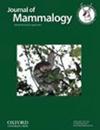Movement response of small mammals to burn severity reveals importance of microhabitat features
IF 1.5
3区 生物学
Q2 ZOOLOGY
引用次数: 0
Abstract
Disturbance events are increasing at a global scale, with cascading impacts to ecosystems and residents therein that include fragmentation and altered vegetation structure and composition. Such changes may disproportionately impact small mammal movements, risk perception, and community dynamics as smaller species perceive such changes at finer spatial scales. We examined movement response to burn severity, vegetation structure, and composition in Mexican woodrats (Neotoma mexicana), a common but understudied small mammal species. The study was conducted on Mt. Graham in southeastern Arizona, United States, following a fire that burned over 19,400 ha. We measured path tortuosity of woodrats translocated over patches of different burn severity. Tortuosity can indicate microhabitat selection, foraging behavior, and perceived predation risk—features affecting population-level processes that changes in community composition alone cannot fully demonstrate. We captured woodrats, released them 50 m away from their midden, and used fluorescent powder to track woodrat movement paths through areas of low–severe burn severity. We analyzed features of the resulting powder trails including straightness, average step length, fractal dimension, and squared displacement. We also compared used versus expected vegetation structure and composition along movement paths across burn severities. Analyses indicated shorter step length with increased bare ground, as well as higher squared displacement in areas with more logs. Vegetation analyses likewise showed that logs were heavily used in low-burned areas, whereas dense vegetation was avoided in highly burned areas. Burn severity alone did not have a direct effect on movement parameters, rather its influence on vegetative composition and structure appears to be most important. Selection for logs and avoidance of dense vegetation may be attributed to auditory concealment and ease of travel. With projected increases in wildfire extent and severity, this work represents an understudied approach to understanding these disturbances and their effects on ecological communities.小型哺乳动物的活动对烧伤严重程度的反应揭示了微生境特征的重要性
扰动事件在全球范围内日益增多,对生态系统和其中的居民造成了连带影响,包括支离破碎和植被结构与组成的改变。这种变化可能会对小型哺乳动物的运动、风险感知和群落动态产生不成比例的影响,因为小型物种能在更精细的空间尺度上感知这种变化。我们研究了墨西哥林鼠(Neotoma mexicana)的运动对燃烧严重程度、植被结构和组成的反应,墨西哥林鼠是一种常见的小型哺乳动物,但研究不足。这项研究在美国亚利桑那州东南部的格雷厄姆山进行,火灾烧毁了超过 19,400 公顷的土地。我们测量了被转移到不同烧伤严重程度斑块上的木鼠的路径曲折度。迂回度可以显示微生境选择、觅食行为和感知到的捕食风险--这些特征会影响种群水平的过程,而仅仅群落组成的变化并不能完全证明这一点。我们捕捉了木鼠,将其释放到距其栖息地 50 米远的地方,并使用荧光粉末追踪木鼠在低度严重焚烧地区的移动路径。我们分析了荧光粉轨迹的特征,包括直线度、平均步长、分形维度和位移平方。我们还比较了在不同烧伤严重程度的移动路径上使用的植被结构和组成与预期的植被结构和组成。分析表明,裸露地面越多,步长越短,原木越多的区域,位移平方数越高。植被分析同样表明,低度燃烧地区大量使用原木,而高度燃烧地区则避免使用茂密的植被。燃烧严重程度本身并不直接影响移动参数,相反,它对植被组成和结构的影响似乎最为重要。选择原木和避开茂密植被可能是由于听觉隐蔽性和行进方便性。随着野火范围和严重程度的预计增加,这项工作是了解这些干扰及其对生态群落影响的一种研究不足的方法。
本文章由计算机程序翻译,如有差异,请以英文原文为准。
求助全文
约1分钟内获得全文
求助全文
来源期刊

Journal of Mammalogy
生物-动物学
CiteScore
3.30
自引率
5.90%
发文量
106
审稿时长
4-8 weeks
期刊介绍:
Papers are published on mammalian behavior, conservation, ecology, genetics, morphology, physiology, and taxonomy.
 求助内容:
求助内容: 应助结果提醒方式:
应助结果提醒方式:


